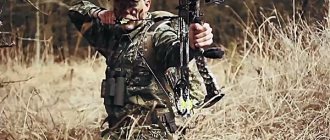Despite the fact that at first glance the situation in the world and around us is stable, the threat of war or health hazard always exists and is always nearby. Even the country's General Staff plays out an imaginary attack from time to time. And this is not because our generals have absolutely nothing to do. This is done so that soldiers and the country as a whole are always prepared for possible unforeseen situations. Although, in fact, there is constant war in the world. What is the cost of the war against terrorism, which is considered the most dangerous enemy. After all, it is unknown where he is and who he is. Perhaps he walks very close or lives next door to each of us.
Such a movement as terrorism did not appear yesterday; it has existed for a very long time and has only looked different at all times. Of course, after reading this article, you shouldn’t fly to the store to buy a means of protection for yourself, even if it’s not the best, but nevertheless very necessary - a gas mask. If necessary, of course, each state has reserved this attribute of protection for the population. But still, it doesn’t hurt to be able to make it yourself.
How to make a gas mask with your own hands
In order to learn how to do this, you don’t need any special skills, but first you need to prepare:
- 2l plastic bottle;
- textile;
- stationery knife;
- a little cotton wool;
- linen elastic;
- electrical tape or tape.
- Step 1. Carefully cut off the bottom of the prepared bottle with a stationery knife. Cut a mask shape from the body of the bottle.
- Step2. Moisten the prepared small piece of cloth.
- Step3. Place the damp cloth evenly inside, spread the cotton wool and wrap it in the cloth.
- Step 4. Cover the open neck of the bottle tightly with a cloth and cotton wool.
- Step 5. Insulate the cut edges of the bottle with tape or tape to avoid cuts.
- Step 6. Make a hole along the edges into which to insert an elastic band, according to the size of your head, tying the ends into knots.
This is interesting: Fishing for pike with a spinning rod - choosing bait, spinning rod and gear
Homemade gas mask from a plastic bottle
In order to make a gas mask with your own hands at home, we will need:
- Two liter plastic bottle
- Stationery knife
- Glue and tape
- Cotton wool and gauze
- Piece of cloth
- Activated carbon
- Two pieces of PVC pipe 150 mm long and 25-30 mm in diameter.
- Linen elastic
Using a utility knife, cut off a third of the bottle at the place where its conical part becomes cylindrical. It turns out to be a funnel with a neck. This will be the basis of the gas mask. We cut out part of the funnel under the nose and try it on. If the mask fits tightly, we treat the cut edge with tape or tape so that it does not get scratched.
We drill holes in the cork. From the end, around the circumference, glue a piece of fabric, trim off the excess. This will be the breathing valve. Lubricate the thread with glue and screw on the plug. It should sit tightly. On the sides of the funnel, near the corners of the lips, we cut out 2 holes for PVC pipes, from which we will make filters.
We fold the bandage in several layers and glue it to the end of the tube. Place two crushed activated carbon tablets into the tube. We take the cotton wool and fluff it, pulling it apart. Place the pieces in a tube. No need to tamp. When 5 mm remains to the top of the tube, add activated carbon again. We seal the end with a plug made of several layers of bandage. We cut off the excess around the circumference. By analogy with the first filter, we make the second one. We fix the filters with tape in the holes of the mask, where the PVC pipes should fit only a few millimeters. Otherwise they will get in your face.
All that remains is to cut 2 small holes in the mask for the elastic band, cut it to the size of your head and tie it on. You can make a gas mask not only for yourself, but also for your family.
How to choose the right gas mask
Select the correct mask size and check its serviceability and performance. To do this as efficiently as possible, you need to know the size of your head. How to measure your head size correctly. Using a measuring tape, “envelop” the shape of the face with it, starting from the top of the head along the cheeks and chin until the second end of the tape connects with the first (at the top of the head). Round the resulting data to 0.5.
When inspecting a gas mask, carefully inspect it for cracks or other damage: in the helmet, connecting tubes, or on the glass of glasses. Whether the valve is working correctly or working at all. The filter box must not be wrinkled or damaged.
This is interesting: Beaver hunting dates
Simpler options for a home gas mask
The technology described above requires a certain amount of time and some materials. What if an alarming message has already sounded on the radio or television, and at home you have nothing in your first aid kit except plastic bottles of lemonade and activated carbon tablets? A way out can also be found in this case by making a home gas mask. We make many small holes in the bottom of the bottle with a drill or awl. We push a round piece of bandage or fabric into the neck hole along the diameter of the bottom. Using a knitting needle or wire, straighten it at the bottom. Pour in crushed activated carbon. If you don’t have it, regular charcoal for kebabs and barbecues will do. You just need to blow off any dust before putting it in the bottle. The primitive gas mask is ready. You need to breathe through your mouth through the neck and exhale through your nose. It’s not very convenient, but what can’t you do to keep your life safe? Instead of a bottle, you can use a tall tea or coffee tin. Then you will have to make a hole in the top cover for the hose, which is secured with tape. You will breathe through the hose, exhale through your nose. Well, what if there is no time left to make a gas mask with your own hands at home? Then the simplest option will help out. Wet any fabric under running cold water: a handkerchief, a towel, a scarf, wring it out and breathe through the fabric, pressing it tightly to your mouth.
Making a respirator with your own hands (algorithm)
Having prepared everything you need, you can begin making a respirator. The order of work in this case is as follows.
- We cut off the top of the plastic bottle in a circle. The latter must be selected depending on the structure of the face and anatomical features of the person so that in the end the mask fits without gaps.
- In the cut area with scissors, we make a recess for the bridge of the nose (the top of the respirator), and on the sides, in the middle part, there are two holes with a diameter of 5-7 millimeters, which will serve for air intake.
- Next, we sand the sharp edges of the plastic mask, then apply glue to them and glue the cut rubber tube from the dropper so that the respirator does not scratch the face and fits more tightly.
- Remove the cover and make two triangular holes in it. They should be located opposite each other, and one of the corners of each triangle should be directed towards the center of the lid.
- Apply glue to the lid between the triangular holes and glue a circle of cellophane to it, the diameter of which is equal to two centimeters. As a result, we get a return valve.
- We make valves for air flow inside the mask from syringes. To do this, remove the piston and cut off the wall with the needle mount, after which we glue the resulting cylinders to the bottle, aligning them with the side holes made in advance.
- After the glue has dried on all seams and joints, screw the cap onto the neck of the former bottle, and fill the syringe cylinders with cotton wool, which has previously been crushed.
- Finally, we glue textile tapes or straps to the edges of the mask, with which the respirator will be held on the head.
This is interesting: How to make a compass with your own hands at home for children for school
A respirator of this design can easily cope with dust arising during repairs. If you need to protect yourself from smog, gases or toxic fumes, you need to add crushed activated carbon to the filter fillers (cotton wool in syringe cylinders). For one time, it is enough to use two tablets, crushed into powder.
Obviously, it is absolutely not difficult to make such a protective mask with your own hands. At the same time, it won’t take much time to make a respirator, and the costs will be completely ridiculous.
How to make a gas mask at home. Instructions for assembling a gas mask at home
The world we live in today is one in which anything can happen, and this means that planning for different survival situations is a must. Being prepared even in the most dangerous situations is the same as making all kinds of household items that can save your life in the event of a disaster.
One of the skills you must master is to quickly create a gas mask, as there are often a number of dangerous events such as a fire or terrorist attack where owning a gas mask can be life changing. and death. ,
Principles for constructing a reliable gas mask
Thus, the gas mask filters toxins in the air using the principle of adsorption and the principle of safety. Store-bought products have these characteristics, and some of the more competent ones are better for adsorption and safety, as they can filter out more foreign substances and be more effective even in highly toxic environments.
On the other hand, homemade gas masks are just that: homemade items, and given the fact that you don't have high-quality materials or the most advanced tools at your disposal to make sure everything is sealed and working flawlessly, you may run into problems when it comes to adsorption. and safety.
However, a quick look at these two key principles will help you understand how to make a better homemade gas mask.
adsorption
There is an important difference between absorption and adsorption . The former term refers to the process of encapsulating a substance, while adsorption refers to the deposition of a particular substance on a surface. In other words, you don't want your gas mask to be absorbent but adsorbent, which means it is capable of filtering out all kinds of dangerous particles and gases that could otherwise get stuck in your nose or lungs and damage your respiratory system, leaving you unconscious .
Adsorption can be increased by appropriate chemical reactions, taking into account that some substances interact and repel or attract each other. So, if the air particles you want to neutralize are positively charged, you should use a negatively charged gas mask substrate such as activated carbon or zeolites. The effectiveness of this principle has already been proven even in the most common situations: in the event of a fire, it is useful to know that covering your mouth and nose with a damp cloth is a good idea.
Conversely, this principle only works when it comes to particles that are a direct result of combustion, such as a fire or explosion, but it does not work as well when it comes to toxic gases or pathogens in the air.
Safety
Absorption also plays an important role in creating a gas mask, since the filter must not only separate hazardous substances from the air, but also retain them. So, if the filter is not very absorbent, the life and resistance of your gas mask may be compromised.
So, if the filter can't absorb more dangerous chemicals or particles, it will no longer protect it, which means it will be the same as without the masks. This is why it is recommended to install some type of sealing cap on the air filter to avoid damaging it. But age, humidity and temperature are also factors to consider when it comes to the safety of your gas mask, as they change the chemistry of the filter.
For example, you can create a gas mask today and you won't need to use it for several years. But even if you haven't used it up to this point, it can still get damaged due to the factors listed above. Therefore, it is better to check the performance of your gas mask so as not to risk it becoming completely useless. Even the oldest military gas masks degrade over time, so don't count on the effectiveness of a very old item that may not have been kept in the best condition, as it could endanger your life instead of preserving it.
Additionally, it is always best to stay up to date on news about dangerous substances, as scientific discoveries are constantly being made, and a substance that was considered safe decades ago may be dangerous today. This is the case of blue asbestos, which was introduced into the filters of gas masks used in World War II, which we now know is dangerous and can cause lung cancer. Additionally, chromium is another substance that can lead to cancer.











